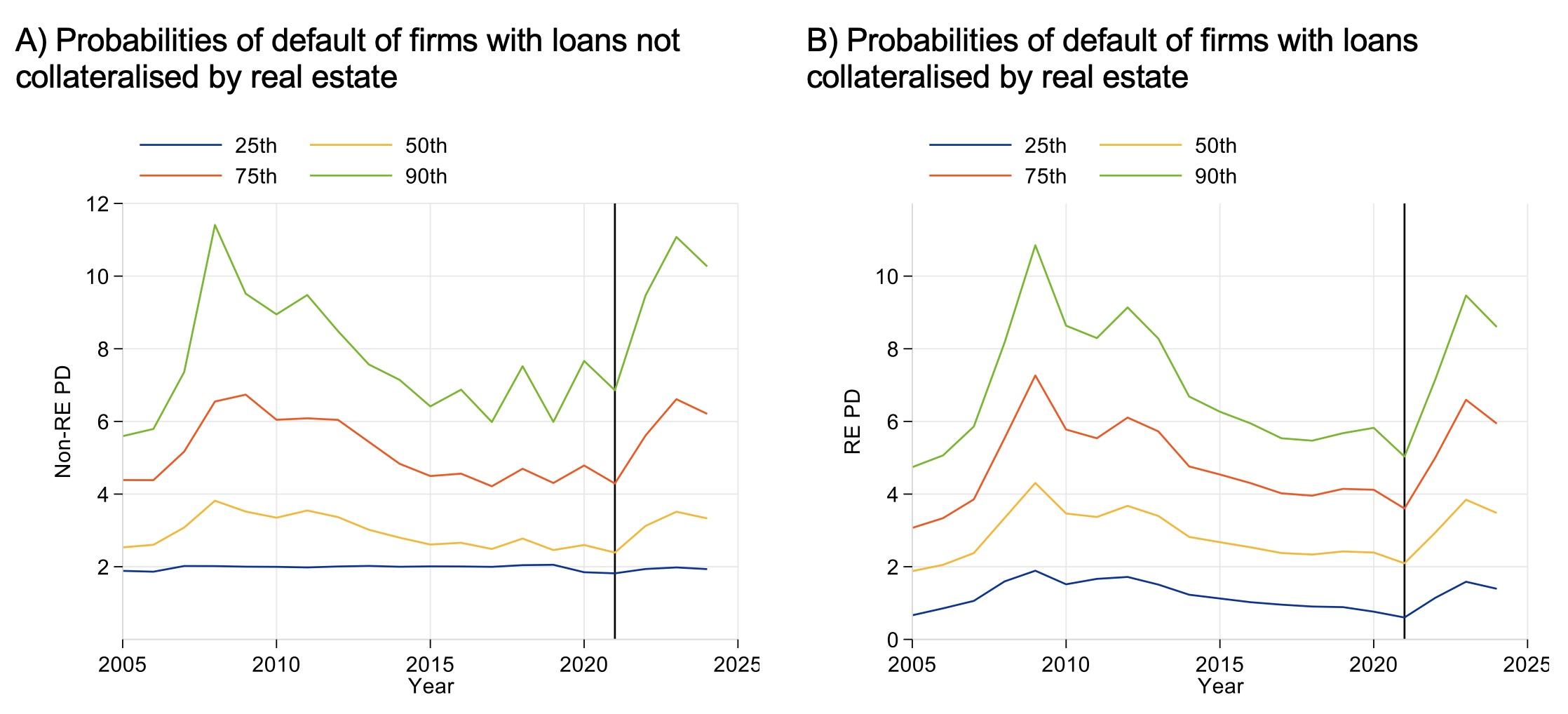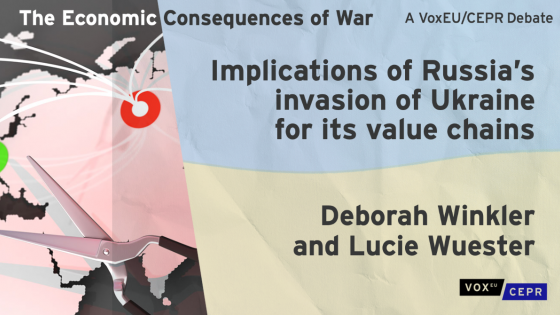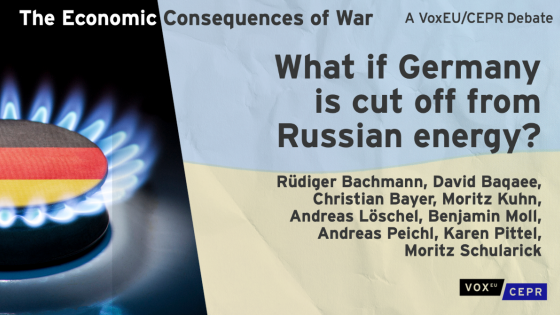Editors' note: This column is part of the Vox debate on the economic consequences of war.
Events such as the Covid-19 pandemic or the Russian war against Ukraine and its implications for corporate debt sustainability and supply chain disruptions illustrate the importance of suitable financial stability monitoring. Stress testing tools should capture the specific impact of exogenous shocks in different economic sectors to ensure that banks exposed to the most affected sectors are adequately provisioned. This column introduces an approach which combines macroeconomic shocks with country and sectoral heterogeneity yielding different probabilities of default for firms across sectors.
Empirical setup
While stress tests are an important financial stability tool, predicting corporate default rates represents a major modelling challenge. The main reason is its non-linear relation with the macroeconomy, especially in deep recessions. Structural credit risk models only account for the average level of default rates at aggregate portfolio level and neglect key firm-specific information. This granular information, however, matters when forecasting the path of default rates over time, as a downturn shock affects economic sectors differently. In addition, different sectors are likely to respond heterogeneously to exogeneous shocks and ignoring such cross-sectional dispersion could lead to biased predictions.
To provide a comprehensive view on the probabilistic nature of default rates, this column introduces a panel quantile regression model, which is applied to granular firm-level data, allowing for non-linearity in the sectoral default probability relative to changes in the set of regressors at the tail of the distribution, including also additional shocks at sectoral level. This approach aims to translate macroeconomic scenarios, as typically used in stress tests, into default rates estimated at the country and sectoral level. The concern that forms the basis for our new application is the fact that the presence of sectoral heterogeneity and non-linearity is often neglected.
The model is built using long time series of country and sectoral-level data, as well as macroeconomic variables to significantly improve the predictive accuracy of the point-in-time probability of defaults. Similar to Kalemli-Özcan et al. (2015), corporate balance sheet information from the Orbis Global Database for five million companies is used to construct representative country samples, covering all euro area countries from 2001 to end-2020, with macroeconomic variables obtained from the OECD. The default variable is defined at the firm level as a binary indicator using balance-sheet information following Gourinchas et al. (2020), where flow default rates are used at the NACE-2 sector level (for more details, see Konietschke et al. 2022). The default rates are regressed against several control variables using a fixed effects quantile regression model as introduced by Rios-Avila (2020) to account for the heterogeneity in macroeconomic shocks to particular industries and potential non-linear sensitivities. This approach follows Adrian et al. (2019) and Cathcart et al. (2020) in the choice of variables reflecting firm fundamentals and their implications for default risks. The macroeconomic variables include housing prices, unemployment, and interest rates and are – in contrast to other specifications and model choices – supplemented by sectoral gross value-added shocks. Thus, induced by country-level scenario changes and sectoral heterogeneity, the model allows to forecast sectoral probabilities of default for any quantile over the chosen scenario horizon.
Assessing the implications of the Russian invasion on corporate probabilities of default
Disruptions in energy, food, and commodity markets could significantly impair a firm’s creditworthiness (Lafrogne-Joussier et al. 2022) and banks’ solvency, although the direct exposures of euro area banks to energy and commodity trading are overall low (SSM 2022). For the purpose of the vulnerability analysis, two possible tail scenarios were tested, which are anchored in the March 2022 ECB staff macroeconomic projections (ECB 2022: Box 6). The adverse and the severely adverse scenarios are designed to capture the direct and indirect impact of the war on corporate probabilities of default at the sectoral level.
Figure 1 shows the probability of default estimates for the adverse and severely adverse scenario at the 75th percentile of corporates, grouped by vulnerable and less-vulnerable sectors. The interquartile ranges represent the probability of default distribution at the country and sector level. Sectors are identified as vulnerable when they are affected by the macroeconomic shock (Attinasi et al. 2022, Bachmann et al. 2022, Winkler and Wuester 2022). The information collected combines data derived from the OECD input-output tables and the NACE-2 level projections of gross value-added at country level produced by Oxford Economics. Sectors that are either highly exposed to trade with Russia or experience a negative shock in their gross value-added over the three-year horizon are classified as vulnerable (e.g. mining and quarrying, oil and gas extraction, and motor vehicles and parts sectors). The model estimates show different risk levels across sectors with an upward shift in the probabilities of default for vulnerable sectors in both adverse scenarios. Vulnerable sectors contribute to an increase in the euro area probability of default of around 20 basis points, corresponding to the average difference between probabilities of default of vulnerable and less-vulnerable sectors over the three-year horizon.1 This results, ceteris paribus, in a decrease in the banks’ common equity tier 1 (CET1) of about 30 basis points,2 over the three-year horizon of the scenario. Albeit moderate in size for the episode and scenarios considered, this differentiated shock sensitivity across sectors reflects the capability of the model to capture firms’ heterogeneity in the estimated probabilities of default under a given scenario.
Figure 1 Projected euro area sectoral probability of default estimates firms
Sources: ECB and authors’ own calculations.
Note: The x-axis shows the projection horizon in years. The y-axis are percentage points displaying the probability of default at the 75th percentile. Bars cover the interquartile range; yellow dots are the median. Blue bars and orange bars aggregate country and sectoral probabilities of default that are less or more (less-vulnerable versus vulnerable) affected by the additional gross value-added shocks. The underlying macro-shocks, apart from the gross value-added element, are the same across all firms within a given country. The most vulnerable sectors include Mining and Quarrying (NACE 07-09), Oil and Gas Extraction (NACE 06), and Motor vehicles and parts (NACE 29) sectors.
Looking at euro area probability of default estimations from 2005 to 2024, lower quintiles seem to move closer together, while upper quintiles are characterised by a greater sensitivity to macroeconomic shocks (Figure 2). This holds for the observed realisations during the global crisis, with minor fluctuations in probabilities of default between 2015 to end-2020 and in the most recent projections. As such, the quantile model proves to capture the same dynamics with different amplitudes/severity across quantiles and identifies pockets of vulnerabilities under tail-event shocks. The projections for the Ukraine war seem to exhibit similar increases in default risk as the case for the global crisis and European sovereign debt crisis.
Figure 2 Projected euro area probability of default estimates of firms by quintiles
Source: ECB and authors’ own calculations.
Note: The x-axis are years, with the vertical black line marking the beginning of the projection horizon between 2022 and 2025. The y-axis shows probabilities of default as percentage points for the adverse scenario. The coloured lines represent the gross value-added weighted average of euro area probabilities of default of non-financial corporations at the 25th, 50th, 75th, and 90th quantiles for exposures collateralised and not collateralised by real estate.
Financial stability considerations
Banks and regulators are constantly searching for reliable measures of default. Models relying on data aggregated at the country level may pass a set of basic criteria for economic and econometric soundness but may imply unduly benign risk parameter responses to possible adverse scenarios. This therefore poses a risk for a bank to be significantly under-provisioned, depending on its sectoral concentration.
It is known that several factors contribute to the increase in probabilities of default, including the deterioration in the macroeconomic environment, the higher short- and long-term rates, or the decline in housing prices (namely, for loans collateralised by real estate). While the scenario is the same for all sectors within a country, sectoral heterogeneity and additional sensitivity to the shocks in terms of their respective gross value-added cause a stronger downturn of debt sustainability for the most affected sectors. As credit risk is more exacerbated for banks with loans concentrated in firms exposed to exogenous shocks, such as energy and legacy Covid-19 vulnerabilities, the inclusion of sectoral level estimation of probabilities of default has become a crucial element for a robust assessment of credit risk in the stress tests. Thus, the approach presented in this column combines macroeconomic shocks with country and sectoral heterogeneity yielding different probabilities of default for firms across sectors. The sectoral decomposition of corporate probabilities of default not only allows for a more tailored scenario design that incorporates targeted shocks, such as the effects of the Russian invasion on various commodity sectors, but also supports the identification of pockets of vulnerability on banks' balance sheets at a more granular level.
References
Adrian, T, N Boyarchenko and D Giannone (2019), “Vulnerable growth”, American Economic Review 109(4): 1263–89.
Attinasi, M G, R Gerinovics, V Gunnella, M Mancini and L Metelli (2022), “Global supply chains rattled by winds of war”, VoexEU.org, 9 June.
Bachmann, R, D Baqaee, C Bayer, M Kuhn, A Löschel, B Moll, A Peichl, K Pittel and M Schularick (2022), “What if Germany is cut off from Russian energy?”, VoxEU.org, 25 March.
Cathcart, L, A Dufour, L Rossi and S Varotto (2020), “The differential impact of leverage on the default risk of small and large firms”, Journal of Corporate Finance 60: 101541.
European Central Bank (2022), “Financial Stability Review”, Box 6, “Assessing the resilience of the euro area banking sector in light of the Russia-Ukraine war”, May.
Gourinchas, P-O, S Kalemli-Özcan, V Penciakova and N Sander (2020), “Covid-19 and sme failures”, NBER Working Paper 27877.
Kalemli-Özcan, S, B Sorensen, C Villegas-Sanchez, V Volosovych and S Yesiltas (2015), “How to construct nationally representative firm level data from the orbis global database: New facts and aggregate implications”, NBER Working Paper 21558.
Konietschke, P, J Metzler and A P Marques (2022), “Country and sector level specificities in credit risk. A quantile approach for modelling sectoral probabilities of default”, ECB Working Papers, forthcoming.
Lafrogne-Joussier, R, A Levchenko, J Martin and I Mejean (2022), “Beyond macro: Firm-level effects of cutting off Russian energy”, VoxEU.org, 19 April.
Rios-Avila, F (2020), “Recentered influence functions (RIFs) in Stata: RIF regression and RIF decomposition”, The Stata Journal 20(1): 51-94.
Single Supervisor Mechanism (2022), “Supervision Newsletter”, 18 May.
Winkler, D and L Wuester (2022), “Implications of Russia’s invasion of Ukraine for its value chains”, VoxEU.org, 11 May.
Endnotes
1For less vulnerable and vulnerable sectors over the three-year horizon, respectively, 3.3% and 3.5% in the adverse scenario; 4% and 4.2% in the severely adverse scenario.
2 The aggregate starting point euro area banking system CET1 ratio was around 15% (end-2021). These estimates include the expected losses of performing and non-performing loans (stage 3 loans). It is assumed that other impacts and risks remain the same (ceteris paribus).








